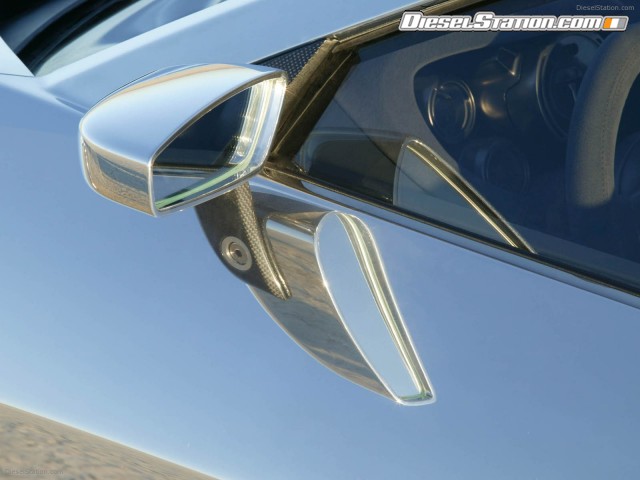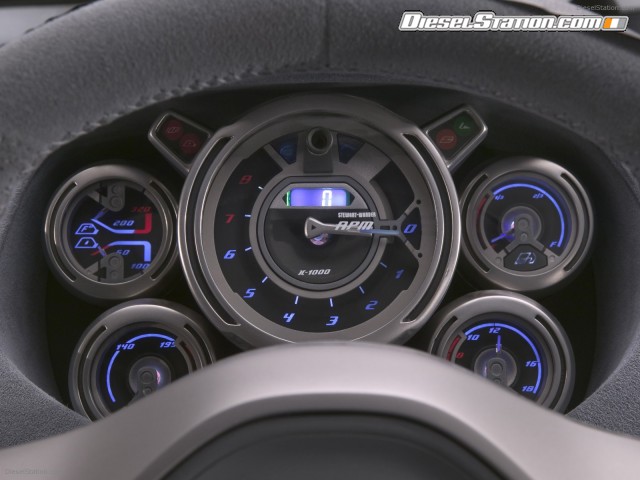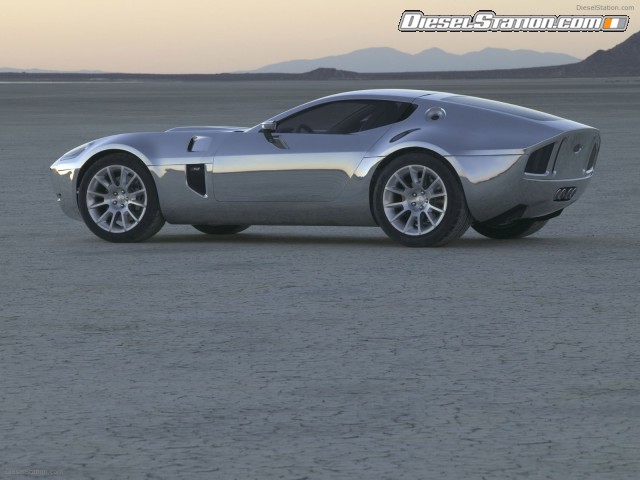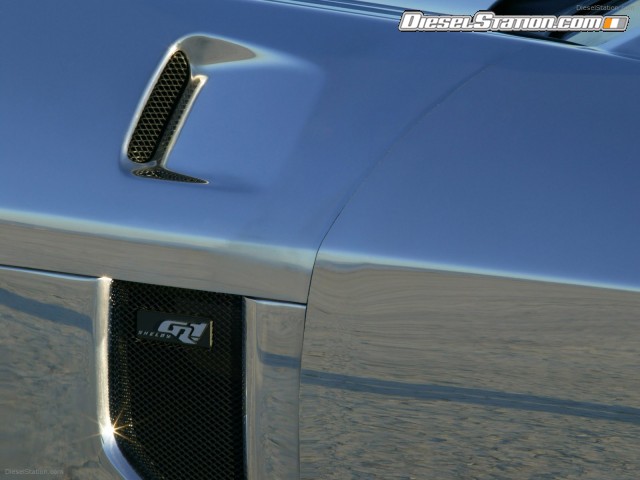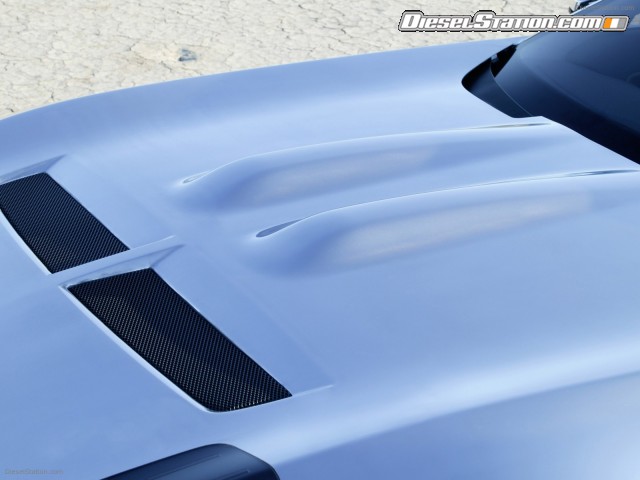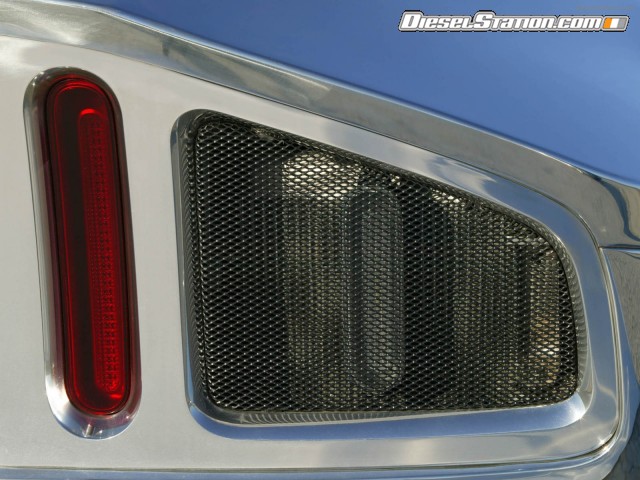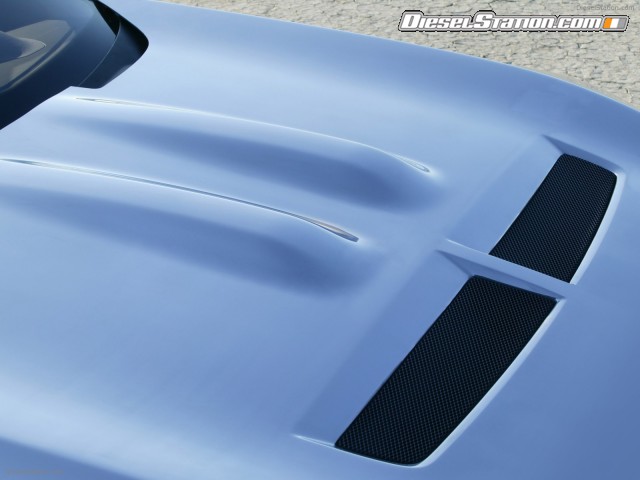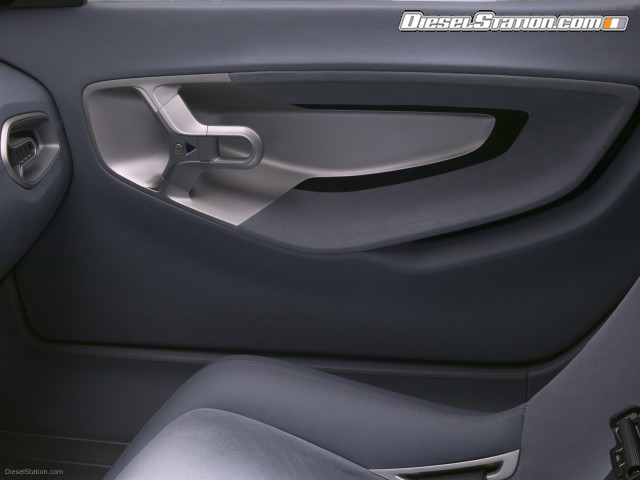- Front-engine/rear-drive, two-seat fastback supercar
- A salute to "performance art"
- Based on Ford GT architecture
- Carroll Shelby inspiration
The Ford Shelby GR-1 concept springs from a long line of Ford performance project cars and quickly establishes itself as one of the most contemporary and dramatic front-engine, two-seat, fastback supercars. This running prototype reaches closer to reality with a 605-horsepower, 390-cubic-inch all-aluminum V-10 engine, a road-tested version of the Ford GT suspension and a stunning new polished-aluminum body.
Sensuous, perfectly proportioned and wholly modern, this show car builds on the success of the Ford Shelby Cobra concept – the 2004 North American International Auto Show (NAIAS) "Best in Show" winner – and reinforces Ford's continued commitment to performance.
The Shelby GR-1 concept's name pays tribute to both a performance great and "Group Racing." This uniquely emotional American sports car design represents Ford's continued desire to include a high-end, limited-production specialist supercar in its lineup. Initially unveiled as a design exercise at the Pebble Beach Concours d'Elegance in August, the Ford Shelby GR-1 concept is a sports car salute to "performance art."
"A perfect body with smooth, shimmering aluminum skin, the new Ford Shelby GR-1 concept is a rolling sculpture whose beautiful, flowing lines belie the raw, beastly V-10 wedged under the hood," says J Mays, group vice president of Design and chief creative officer. "This concept shifts gears and takes Ford's performance car future into a new direction."
The Shelby GR-1 concept combines modern sculptured surfaces and a sleek muscular fastback design. All of the sophisticated mechanicals of this extraordinary coupe are wrapped in a sleek, muscular aluminum skin left bare and polished bright. The result is a forward-looking supercar with attention-grabbing Ford presence and Carroll Shelby inspiration.
A REALITY-BASED CONCEPT
Much like the original Ford GT and last year's Shelby Cobra concept vehicles, the Shelby GR-1 was intended to be a fully engineered, production-feasible roadgoing, drivable project vehicle.
"With the Ford GT and Ford Shelby Cobra concept, we have a tremendous amount of experience quickly building high-performance cars, like the Shelby GR-1, with world-class performance," says Phil Martens, group vice president, Product Creation. "Our goal this time around was not to create the ultimate top-speed, high-performance sports car. Really, we intended to strike a better balance of design, capability and usability that might appeal to someone considering a Ferrari 575M Maranello."
The Shelby GR-1 starts with a modified version of the aluminum chassis from the rear-engine Ford GT. The bulk of the rear structure is made from slightly modified Ford GT components, including the massive trellis-like, cast-aluminum suspension nodes, the rear rails and bumper beam, a major cross-member and the brackets used to mount the transmission.
The center portion of the spaceframe also borrows liberally from the Ford GT as major aluminum extrusions are based heavily on existing pieces. At the front of the coupe, the team incorporated extruded main rails, a steering rack cross-member, crash-management sections and the bumper beam from the Ford GT.
"Building a concept car with this level of sophistication is much easier when you start with a world-class supercar like the Ford GT," says Martens. "This commonality and re-use goes hand-in-hand with our speed and cost efficiency, promising the Ford GT's bang-for-the-buck equation if the Shelby GR-1 goes to production."
Overall, the Ford Shelby GR-1 concept is more than two feet shorter than the Ford GT, with a wheelbase nearly seven inches shorter. The track width has been reduced by more than an inch. That the concept car and the GT share any parts at all is a testimony to the flexibility of the space frame design and the creativity of the chassis team.
SHAPELY EXTERIOR
The Ford Shelby GR-1 is a sinewy, athletic design with a long hood that blends seamlessly into the teardrop-shaped cabin with a fastback roofline and falling upper fender line. The car looks as if it is in motion, even when it is standing still.
The optimized wheel arches and compact overhangs define the striking stance while the strong shoulder line and smooth, taut surfaces express the car's graceful yet athletic nature. The polished aluminum body panels further express the highly sculptured surfaces and define the emotional proportions in dramatic fashion.
The front of the Shelby GR-1 concept is dominated by an air-intake aperture and airflow splitter, directing cool air into the engine bay and wheel wells, while air vents on the upper surface of the hood exhaust hot air from the radiator. Additional intakes and vents perforate the body side to ensure cooling throughout.
The front corners of the Shelby GR-1 are dominated by substantial front wheel wells housing 19-inch wheels and tires and trapezoidal High Intensity Solid State (HISS) headlamps that float above the wheel arches. This highly technical lighting package provides powerful illumination in a very compact package, allowing freedom of design without sacrificing nighttime driving visibility.
In the rear, a distinctive Kamm tail tapers to improve wind drag and features integrated transmission cooler outlets and a ground-effects venturi. It is further defined by a strong concave section and bold vertical taillamps.
The Shelby GR-1 concept sits on 19-inch, 12-spoke milled aluminum wheels and features Goodyear 275/40R-19 tires in the front and 345/35R-19 tires in the rear, mated with the unique Tire IQ™ system, which allows the driver to monitor precise tire performance.
RACING-INSPIRED INTERIOR
The Shelby GR-1 concept's butterfly doors have distinctive teardrop-shaped side-glass graphics that create an elongated appearance, blending seamlessly into integrated door-release handles.
The graceful upward glide of the doors leads into the race-inspired interior that features seats with carbon shells and fixed backs. The carbon shells are connected directly to the sill and tunnel via lightweight aluminum spaceframe attachments and can be adjusted fore and aft by way of an accessible pull ring on the seat cushions' leading edge. The seats incorporate removable Alcantara comfort inserts that are individually tailored to the occupants' body type.
The interior door panels feature air-vent apertures and integrated "door close" pockets. The door release employs a pull-ring themed design with quick-release slide action and an illuminated door lock/unlock indicator. The exposed rear bulkhead cross-car structure braces to the roll hoop and features a snorkel air-register outlet that controls the ambient cabin climate.
Interior cabin technology focuses on driver comfort, enjoyment and entertainment. The instrument panel sports a full complement of analog gauges, including a combination analog tachometer with floating watch-like elements and digital speedometer. The tachometer housing has integrated air registers and an additional Noise Reduction Technology (NRT) output speaker.
The centrally mounted Tire IQ™ display is a sophisticated driver's aid designed to inform, warn and even entertain. The Tire IQ™ system provides the driver and passenger with an animation of vital tire temperature and pressure statistics (via sensors in the tire), along with other key vehicle dynamics such as cornering G forces (via an onboard accelerometer).
The center console features integrated toggles that control the fuel pump, ignition, windows, hood and rear-glass release. The race-inspired push-button starter and "baseball grip" gear knob are situated ahead of the parking brake, which has been incorporated into the tunnel armrest. The quick-release steering wheel has integrated headlamp, wiper and direction indicator controls.
Special attention has been paid to noise reduction on the interior. The rear hatch stowage compartment features a removable MP3/Amp and NRT console, while audio input, output and recording speakers are integrated into the headrest protection wings on each seat. The speakers can provide a combination of the following:
- Noise-reducing sound waves (NRT) for improved highway cruising noise levels
- Play or record (for playback) pace notes
- MP3 Audio
The MP3/AMP/NRT functions can be interfaced through the Tire IQ™ display through a joystick controller.
Throughout the interior, the leather trim is in slate gray, with color-matched perforated Alcantara leather featured on touch zones such as the gear knob, parking brake, steering wheel, door inserts, and instrument/Tire IQ™ binnacles. Functional zones such as dials, door release and center console switchgear have been finished in a combination of anodized gunmetal finishes.
Ambient cabin lighting is neatly packaged behind the central headlining panel; an indirect blue glow appears around the periphery offset of the panel. The headliner and upper doorframes are trimmed with a woven aluminum-metalized fabric that lightens the interior ambiance and heightens the slate grey tones of the leather and Alcantara trim. The dark gunmetal-gray flooring also is trimmed in the hard-wearing metalized fabric.
PROVEN CHASSIS COMPONENTS
From the outset, the Shelby GR-1 concept team intended the concept to perform at supercar levels but with a more "mature" feel biased a little more toward driver comfort than the Ford GT – widely noted for its balance of dynamics and road manners – and last year's Ford Shelby Cobra concept.
They started by attaching massive 19-inch wheels and tires using the Ford GT suspension system with a few modifications to accommodate the increased weight of a front-engine setup. The new Ford GT earns praise for its combination of agility, grip and easy-to-drive character, a reflection of its sophisticated suspension design and the expertise of its chassis engineers. The Ford Shelby GR-1 concept applies the best of the GT suspension to a supercar with different performance intentions.
"The biggest difference between the GR-1 concept and our past efforts is the emphasis on overall driver comfort," says Manfred Rumpel, manager, Ford Advanced Product Creation. "That extends all the way to the compliant yet high-performing capability we built into the suspension."
DESIGNED-IN SUSPENSION COMPLIANCE
A double-wishbone suspension design with unequal-length aluminum control arms, coil-over monotube shocks and stabilizer bars is used front and rear. The upper control arms are identical at all four wheels and are made with an advanced rheo-cast process that allows the complexity of form associated with casting while retaining the strength of forging. The metal, heated to just below its melting point, is the consistency of butter when it is injected into a mold at high pressure. Pressure is maintained as the part cures, preventing porosity in the final product for exceptional strength.
The steering rack also is borrowed from the Ford GT, with a few modifications. The steering, like the Ford GT's, draws on Ford's global driving dynamics DNA introduced with the Ford Focus' industry-leading steering column featuring light efforts, low friction and high stiffness. Braces between the front shock towers and below the isolated engine mounts improve torsional rigidity and aid steering response.
BIG, POWERFUL BRAKES
With more than 600 horsepower available at the throttle, the brake pedal had to be equally powerful. The team set braking distance targets comparable with today's best supercars and turned to the Ford GT braking system for suitable components.
Brembo "monoblock" one-piece aluminum brake calipers with four pistons each grab cross-drilled, vented discs at all four wheels. The discs are a massive 14 inches in front and 13.2 inches in the rear, for fade-free stopping power. Brake balance is biased slightly to the front wheels to aid stability.
For packaging reasons, the team devised a novel offset actuation linkage for the brake booster and master cylinder, so the brake pedal can be placed in a normal position even though its hardware is off to the side of the engine bay. The kinematic linkage concept for the remote booster actuation was an idea borrowed from the European Ford Mondeo.
"The unique remote booster had to be just right so you can slow the car in a linear and proportional way," says Rumpel. "This means the pedal effort and travel are proportional to the vehicle deceleration rate, which is especially important in high-performance sports cars."
The one-piece, 12-spoke BBS wheels are wrapped by Goodyear Z-rated racing slicks, size 275/40R-19 in front and 345/35R-19 in the rear.
SUPERCAR POWERTRAIN
The heart of any supercar is its engine, and the Ford Shelby GR-1 concept does not disappoint.
Inspired by the biggest, baddest engine of them all – the renowned 427 – Ford engineers created a new aluminum-block V-10 to power last year's Ford Shelby Cobra concept. This 390 cubic inch, 6.4-liter engine, reprised for service in the Shelby GR-1 concept, is adapted from Ford's MOD engine family. It delivers the rush of raw power – with 605 horsepower and 501 foot-pounds of torque – associated with that big 1960s V-8 powerplant without the aid of supercharging or turbocharging.
This combination of brute force and thorough engineering has created a rarity in the world of auto shows – a concept car that can actually do, rather than merely promise, 0-60 in under four seconds, and would easily exceed 200 mph if not electronically limited.
"After I drove last year's Cobra concept, I knew we had a winner in the 6.4-liter V-10," says Carroll Shelby, renowned race driver and consultant on the Ford Shelby GR-1 concept. "We decided to transplant that engine directly into the GR-1 with practically no changes, right down to the rear-mounted transmission, which really helps the weight distribution."
For approximately three years, the Ford powertrain team has been working on an all-aluminum V-10 targeted at ultimate, naturally aspirated performance. When they bolted this modern-day big-block into a Mustang chassis for evaluation, it only took one drive to confirm its potential.
"When we found out there was yet another concept car with the Shelby name on it, we knew it begged for this engine," says Graham Hoare, director, Ford Research and Advanced Engineering. "Although it's not yet ready for production, we've reached a credible engineering level for such a serious concept car – and it has a modern soul that matches the Shelby mission."
ADVANCED TRANSMISSION
While the Ford Shelby GR-1 concept shares a significant amount of technology with the Ford GT and the Shelby Cobra concept, the team met several unique engineering challenges head-on.
First, the six-speed manual transmission had to be packaged in a way that would not compromise the occupant footwells. "One of the unique solutions we delivered for the GR-1 concept was the design, engineering and development of a torque-tube driveline, which allows placement of the transmission in the rear of the car behind the occupant zones," says Rumpel.
The rear-mounted six-speed transaxle is identical to the high-performance unit in the Ford GT, with an integral limited-slip differential to drive the rear wheels. Based on the engine's 7,500-rpm redline and the wide drive ratios, this Ford Shelby GR-1 concept has a theoretical top speed of around 200 mph, although it's electronically limited – for now.
The transaxle application was necessitated by the desire to fit such a large engine into a compact coupe while leaving enough room for the driver's legs and feet. With a conventional transmission mated to the back of the engine, the tradeoff between hood length and passenger room often makes for a cramped footwell and dramatically offset pedals.
Mounting the transmission in the rear helped to more evenly distribute the vehicle's weight and increased the footwell area from 16.5 inches to 21.7 inches, resulting in almost three inches more legroom than in similar performance vehicles.
The legroom-saving torque-tube driveshaft runs at engine speed, considerably faster than typical driveshafts mounted to rear of the transmission. The spinning inner shaft is supported within a stationary outer tube that stabilizes the engine and transmission in bending and in torsion. The inner shaft taps crankshaft torque via a twin-disc, small-diameter clutch mounted at the rear of the engine.
Computer-aided design was essential in helping the first prototype come together smoothly.
"Because they spin so much faster than driveshafts, these torque tubes can be a challenge to execute properly in terms of vibration," says Rumpel. "Using our electronic tools, we optimized the location of the driveshaft support bearings, and it ran smoothly on the very first try. This type of modern engineering tool gives us a development advantage that pioneers like Carroll Shelby could only dream about."
UNIQUE SOLUTIONS
Additional improvements from the Ford Shelby Cobra concept include new, twin fuel fillers exiting the bodywork just aft of each sideview window and mid-way up the rear quarter panel bodywork. These racing-inspired devices feed two individual 10-gallon capacity fuel tanks that reside inside the structural chassis directly behind the passenger compartment.
The battery was also relocated to the rear of the vehicle, deep inside the luggage compartment, further aiding vehicle weight distribution and better shielding the battery package from the intense heat of the engine compartment. A new cooling system, evolved from the Shelby Cobra concept, includes a unique hood with twin portals to feed air into the engine compartment.









